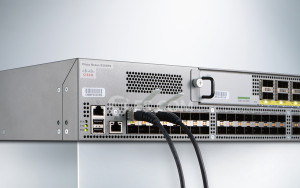What Is Direct Attach Copper Cable?
 Direct attach copper cable, namely DAC cable, are a form of optical transceiver assemblies used to connect switches to routers and/or servers. They are becoming increasingly popular in the network industry, mainly because the price difference is so large when compared with regular optics. There are various versions of direct attach copper cables with different specifications on the market today which make us in difficult choices. So, what should be considered when we buy the direct attach copper cable? Just keep reading, you may find the answer in this post.
Direct attach copper cable, namely DAC cable, are a form of optical transceiver assemblies used to connect switches to routers and/or servers. They are becoming increasingly popular in the network industry, mainly because the price difference is so large when compared with regular optics. There are various versions of direct attach copper cables with different specifications on the market today which make us in difficult choices. So, what should be considered when we buy the direct attach copper cable? Just keep reading, you may find the answer in this post.
Direct Attach Copper Cable Types: Passive or Active?
A passive direct attach copper cable, such as the 10GbE SFP+ cable, is effectively viewed as a transparent cable to the switch and requires little to no direct power to operate. A passive cable therefore passes the signal through it without any modification or processing such as amplification or equalization. Whereas active direct attach copper cable contains electrical components in the connectors that boost signal levels that make data available to transmit for longer distance. In general, active direct attach copper cables are slightly more expensive than the passive cable. How to determine which type should be used? In addition to the consideration of cost and transmission distance, the most reliable method is to check the compatible matrix of your switch. Because some of the switch may not support the passive version, like Brocade VDX.
Direct Attach Copper Cable Buying Guide: Choose the Right Connector
DAC cable terminated with SFP+ connectors is commonly used in 10GbE networks. However, there are many other connector options for DAC cables which meet the interconnection demands of higher speed networks. Thus, choosing the right connector according to your network requirement is very important. In general, you could choose the SFP+ for 10GbE, QSFP+ for 40GbE, SFP28 for 25GbE and QSFP28 for 100GbE. In addition, breakout DACs like QSFP+ to 4x SFP+ DAC is an ideal choice for 10G to 40G migration.
Direct Attach Copper Cable Buying Guide: AWG Is Also an Important Factor
AWG is another important factor of DAC cables. General specifications like 24AWG, 28AWG and 30AWG are available in the market. Always remember a rule when choosing the AWG—the longer the distance, the higher the AWG rating should be.
Direct Attach Copper Cable Buying Guide: Choose the Enough Length
The maximum cable length differs from passive and active DAC cables. Generally, passive cable supports 5 meters or shorter lengths. Whereas active cable can support more than 5 meters (up to 15 meters). Thus, when the distance between connection points is less than 5 meters, passive DAC cable is recommended to use but ensure that your switch can support the passive cable (refer to the first guide). When the distance exceeds 5 meters, it is highly recommended to use active DAC cables to ensure the signal is transferred all the way through. The cost may be a bit higher, but the signal is improved and gives peace of mind by creating a trustworthy connection.
Direct attach copper cables are a low-cost alternative to traditional fiber and twisted-pair copper cabling in top-of-rack and middle-of-row. When buying a DACs, parameters such as passive or active, cable connector, AWG, length and so on should be properly selected. This post is a simple buying guide for reference. If you want to purchase high-quality and cost-effective DAC cables, it is highly recommended to visit FS.COM or contact sales@fs.com for more details.
Related Articles:
SFP+ DAC Twinax Cable Deployment Considerations
Use High Speed Direct Attach Cable for Data Center Interconnection
DAC Cable Wiki: Things You Should Know Before Buying DAC Cable



